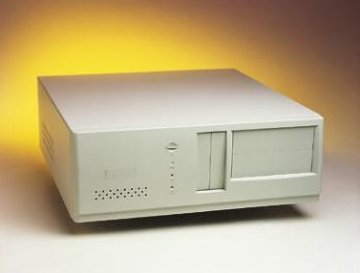[ The PC Guide | Systems and Components Reference Guide | System Case | Styles and Sizes ]
Desktop Case
The desktop has been the de facto standard for PC cases since the original IBM PC, XT and AT machines, which came in a desktop case only. Today's desktops are different than those ones were, both in size and construction, but the idea is the same: the box sits on the desk, and the monitor sits on the box. For those who don't want to (or cannot) put the case on the floor, the desktop actually saves space compared to a tower case, since the monitor won't sit on top of a tower case. A desktop doesn't, in general, let components cool as well as a similarly-sized tower, and the monitor sitting upon it can be part of the reason.
|
A regular-sized desktop case. Note that the 5.25"
drive bays |
Image � In
Win Development, Inc. |
A further disadvantage of the desktop case is that often, one or more of the internal drive bays is vertical. Hard disk drives are allowed to be mounted vertically but I think it is better to mount them horizontally. In addition, it can be confusing to many users to use a 3.5" floppy disk mounted on its side, as it's hard to figure out which way the disk goes (it will only go in one way).
![]() Note: Virtually all desktop
cases sold today are really "mini" desktops, meaning they are smaller than the
old full-size desktop cases used on the original PC, XT and AT. The designation
"mini" is often not used any more simply because it has been so many years that
these "mini" cases have been the standard. These desktops correspond to the Baby
AT form factor, where the older, larger cases were used with the
older PC/XT and AT form factors.
Note: Virtually all desktop
cases sold today are really "mini" desktops, meaning they are smaller than the
old full-size desktop cases used on the original PC, XT and AT. The designation
"mini" is often not used any more simply because it has been so many years that
these "mini" cases have been the standard. These desktops correspond to the Baby
AT form factor, where the older, larger cases were used with the
older PC/XT and AT form factors.
![]() Next: Slimline Case
Next: Slimline Case
| The PC Guide
(http://www.PCGuide.com) Site Version: 2.2.0 - Version Date: April 17, 2001 © Copyright 1997-2004 Charles M. Kozierok. All Rights Reserved. |
Not responsible for any loss resulting from the use of this site. Please read the Site Guide before using this material. |
